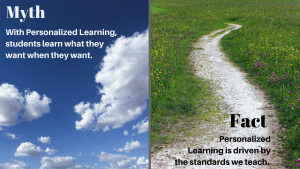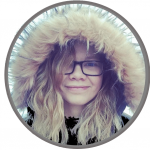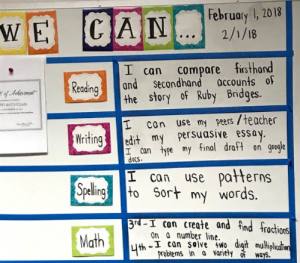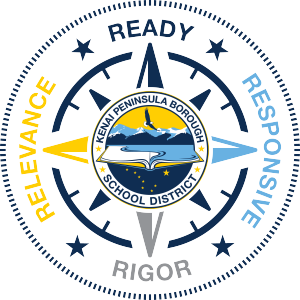Often one of the myths surrounding Personalized Learning is regarding the misconception that students are given completely free reign  over what they study. This is not the case at all. In fact, teachers are bound more than ever to the foundational skeleton of the content areas: The standards! The Alaska State Standards guide all the work that we do as educators. It is what we are bound to teach. It is what our state has determined to be what our students need to know.
over what they study. This is not the case at all. In fact, teachers are bound more than ever to the foundational skeleton of the content areas: The standards! The Alaska State Standards guide all the work that we do as educators. It is what we are bound to teach. It is what our state has determined to be what our students need to know.
With Personalized Learning, we are innovative about the ways that we approach and monitor student progress on the standards, but the standards remain the foundation of education. Amy Angleton, Language Arts teacher at Skyview Middle School who has contributed to this blog in the past goes says it in more depth…
 “The first step to be innovative within the confines of parameters such as standards is to understand the parameters deeply. State Standards are an essential basis for education. Without standards, educators would have no framework for what their students need to know at specific levels in order to prepare them for the next levels. Think of utilizing standards like you would learn a sport. When someone learns a skill in a sport there are foundational skills that a player needs to have before they are able to progress and play the sport as a whole. To learn these skills they practice them slowly and perfectly hundreds of times to create muscle memory. Teachers create muscle memory with the standards. When a teacher knows the standards deeply they do not have to look at them every time they create a lesson that is innovative and creative. They create lessons that address the standards automatically because they have muscle memory, they have become automatic. Of course (just like in sports) it is important to refresh every now and then just to make sure you are on the right track.
“The first step to be innovative within the confines of parameters such as standards is to understand the parameters deeply. State Standards are an essential basis for education. Without standards, educators would have no framework for what their students need to know at specific levels in order to prepare them for the next levels. Think of utilizing standards like you would learn a sport. When someone learns a skill in a sport there are foundational skills that a player needs to have before they are able to progress and play the sport as a whole. To learn these skills they practice them slowly and perfectly hundreds of times to create muscle memory. Teachers create muscle memory with the standards. When a teacher knows the standards deeply they do not have to look at them every time they create a lesson that is innovative and creative. They create lessons that address the standards automatically because they have muscle memory, they have become automatic. Of course (just like in sports) it is important to refresh every now and then just to make sure you are on the right track.
After understanding the standards deeply, then teachers can create checklists and essential skills students will use and be familiar with that are based on standards without using them directly. Then, innovation can really begin. Once a teacher has the end goal set, the skill that students need to master, there are unending possible ways to teach a student to accomplish that goal. There are unending possible choices to give students to take ownership for their own learning. There are online portfolios and projects and videos and explorations that students can all do. This is the exciting part, the moment that teachers articulate the end goal to students is the moment that innovation can begin.”
We see this playing out all over KPBSD! Amy is at a middle school, but if you look at West Homer Elementary, you will see “I can” statements  on their walls. An “I can” statement is the standard that you are trying to teach put into student-friendly and actionable language. For example, the Alaska State Standard says, “ Add up to four two-digit numbers using strategies based on place value and properties of operations.” The “I can” statement for this is “I can add double digits. I can name the place a number is in. I can tell if it is addition or subtraction.” The student knows exactly what they are trying to accomplish!
on their walls. An “I can” statement is the standard that you are trying to teach put into student-friendly and actionable language. For example, the Alaska State Standard says, “ Add up to four two-digit numbers using strategies based on place value and properties of operations.” The “I can” statement for this is “I can add double digits. I can name the place a number is in. I can tell if it is addition or subtraction.” The student knows exactly what they are trying to accomplish!
At the high school level, we find teachers like Meredith McCullough at Kenai Central High School using standards-based grading. Students monitor their progress on the English/Language Arts standards during the course of the semester and provide evidence for their achieving the standards in regular conferences with their teacher. Even at the high school level, standards are put into student-friendly language that students can easily use. This is a clear example of Student Ownership and Reflection, one of the Core Four components of Personalized Learning. Students can progress at the pace that is healthy for them and understand the scope of their work to get credit for a course. This also allows the teachers to provide the resources and assistance that students need to master the standards.
The myth of PL being a free-for-all is clearly busted! Standards drive our work. Teachers and students all over the district use the standards as the basis for what we teach and study. This provides a clear foundation district wide and means that students are receiving their education with fidelity.

The KPBSD Curriculum process is grounded in…. drum roll please….. THE STANDARDS! The curriculum is not a book or a particular resource, but a comprehensive set of learning outcomes, skills, knowledge and assessments that are built from our standards. Because the curriculum is based on standards, this opens up the opportunities for teachers to personalize instruction and resources to support student voice and choice, use of flexible content, and even invite students into the planning process by co-designing pathways and learning goals.